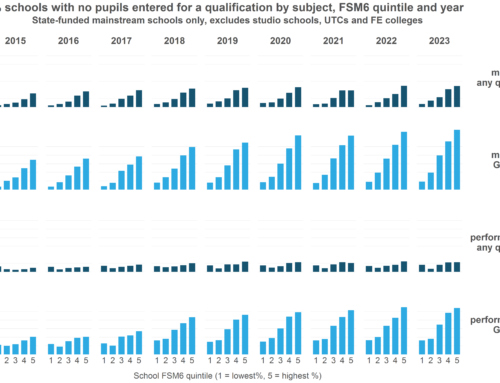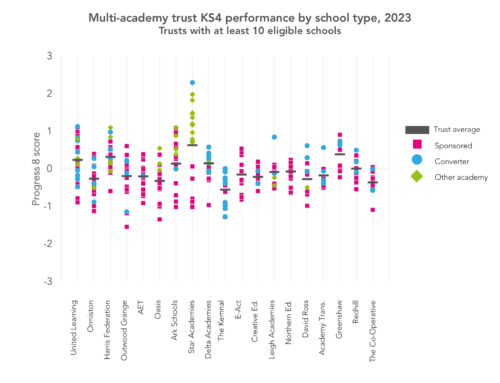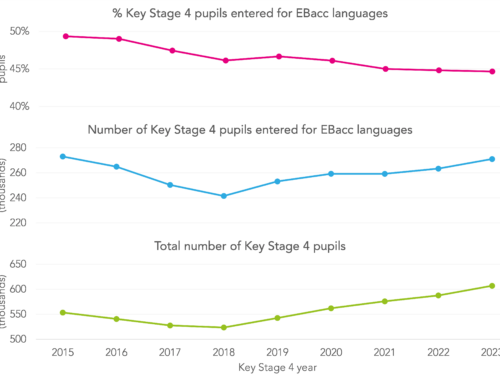Our pupil moves analysis
Three school censuses are carried out each year – in October, January and May – recording which pupils are on-roll at which schools.
Our pupil moves analysis is based on analysis of which schools pupils are recorded as being on-roll at in the termly school census.
In our work we have looked at four cohorts of pupils: those finishing secondary school in 2013/14, 2014/15, 2015/16 and 2016/17.
We count a pupil as being part of a particular cohort based on factors such as the number of censuses in which they have been recorded in a school year that we would expect and whether they counted in the Department for Education’s league tables in a particular year.
This gave a cohort of 563,000 pupils for 2017, for example, of whom all bar 10,000 were observed at some point in a mainstream school, university technical college or studio school that features in our reweighting calculations.
We then looked at all of the instances where a pupil changed school – linking records together where, for example, a school became an academy part way through the period looked at and treating the school as one entity.
How pupils count in school league tables
When it comes to inclusion in mainstream secondary schools’ league table results, everything hinges on the census carried out in the January in which pupils are in Year 11.
Broadly speaking, if a child is recorded as being on roll at a particular school, they count in that school’s results, and if they’re not, they don’t.
There are exceptions. If a pupil arrived in the country in the last two years and comes from a country where English is not the official language they can be omitted from results.
Likewise if a pupil has been permanently excluded from one school in the last two years, another school that accepts them does not have to count that child’s results in their overall results – intended to mean schools aren’t disincentivised from accepting pupils who have been excluded.
If a child is permanently excluded but does not join the roll of another education institution, the excluding school can also ask for that pupil’s results to be attributed to them.
Schools are also allowed to request amendments, in the small number of cases where a pupil has left England permanently, or died.
There are also something called penalty add-backs, which affects how the results of pupils reaching age 16 before Year 11 are accounted for. These pupils are always reported in a school’s results the year after which they have been in Year 10, meaning there is no possibility of them repeatedly being counted as not having reached the end of secondary school.
But, fundamentally it’s a case of: if a child was recorded as having been on-roll at a mainstream secondary school on 19 January 2017, they would have counted in that school’s results in summer 2017.
Reweighting
Our reweighting calculations build on our analysis of pupil moves.
Put simply, results are reweighted according to the amount of time that each pupil has spent on-roll at a school.
For schools that admit in Year 7, a pupil can have spent a maximum of 15 terms there – three terms in each of five years.
So we allocate pupils’ results to the institutions which they have spent time on-roll at as part of their secondary education in proportion to the amount of time they spent on-roll there – 100% if they spent all fifteen terms there; 40% if they spent only six terms there, say.
Under Progress 8, one of the headline accountability measures that has been in place since 2016, expected Attainment 8 scores are calculated for each prior attainment fine grade, based on all pupils who sat Key Stage 2 tests and who complete secondary school in a mainstream school, a university technical college, a studio school or an FE college which admits pupils at 14.
In order to reweight results we have followed the DfE Progress 8 methodology but have calculated expected Attainment 8 scores based on all pupils considered to be part of our cohort, not just those who count in the Department for Education’s Progress 8 calculations.
We have produced two sets of reweighted figures. One of these includes pupils who were either not recorded as having taken any GCSEs or equivalent qualifications, or, if they did, whose results did not count towards any establishment. If a pupil is not recorded as having taken any exams, they are given an A8 score of 0. The second set of reweighted figures excludes these groups of pupils, 50-60% of whom we estimate to have left the population through, for example, emigration.
If a reweighting approach were to be adopted, there would need to be an extension of a mechanism currently in place, to allow schools to request amendments to their results in cases where a child had left England permanently, or died, at any point between Year 7 and Year 11.
Multi-academy trust analysis
Our multi-academy trust (MAT)-level analysis is based on the 2017 MAT league tables published by the Department for Education.
Trusts feature if they had three or more schools that were part of the trust, and had been so for at least three academic years.
Schools are included for a trust if it was part of the trust at the start of the academic year in question – to count in the 2017 MAT league tables, and in our MAT-level analysis, a school had to be part of a trust on 12 September 2016.
School results are weighted according to the number of complete years which a school had been part of a trust, up to a maximum weighting of five (corresponding to five years).
Changes to our methodology
The main areas in which our methodology has changed from our 2017 Who’s Left work are as follows:
- more schools are within the scope of our work this year: decisions about the population of schools of interest have brought into scope schools that have second intakes after Year 7; high schools, university technical colleges and studio schools; schools that had not been open for a full five years (so long as they had Key Stage 4 results); and schools with fewer than 11 pupils who completed secondary education at the school;
- analysis is predominantly focussed on Progress 8, rather than five A*-C GCSEs
Return to the complete Who’s Left 2018 series.
Want to stay up-to-date with the latest research from FFT Education Datalab? Sign up to Datalab’s mailing list to get notifications about new blogposts, or to receive the team’s half-termly newsletter.







Leave A Comment